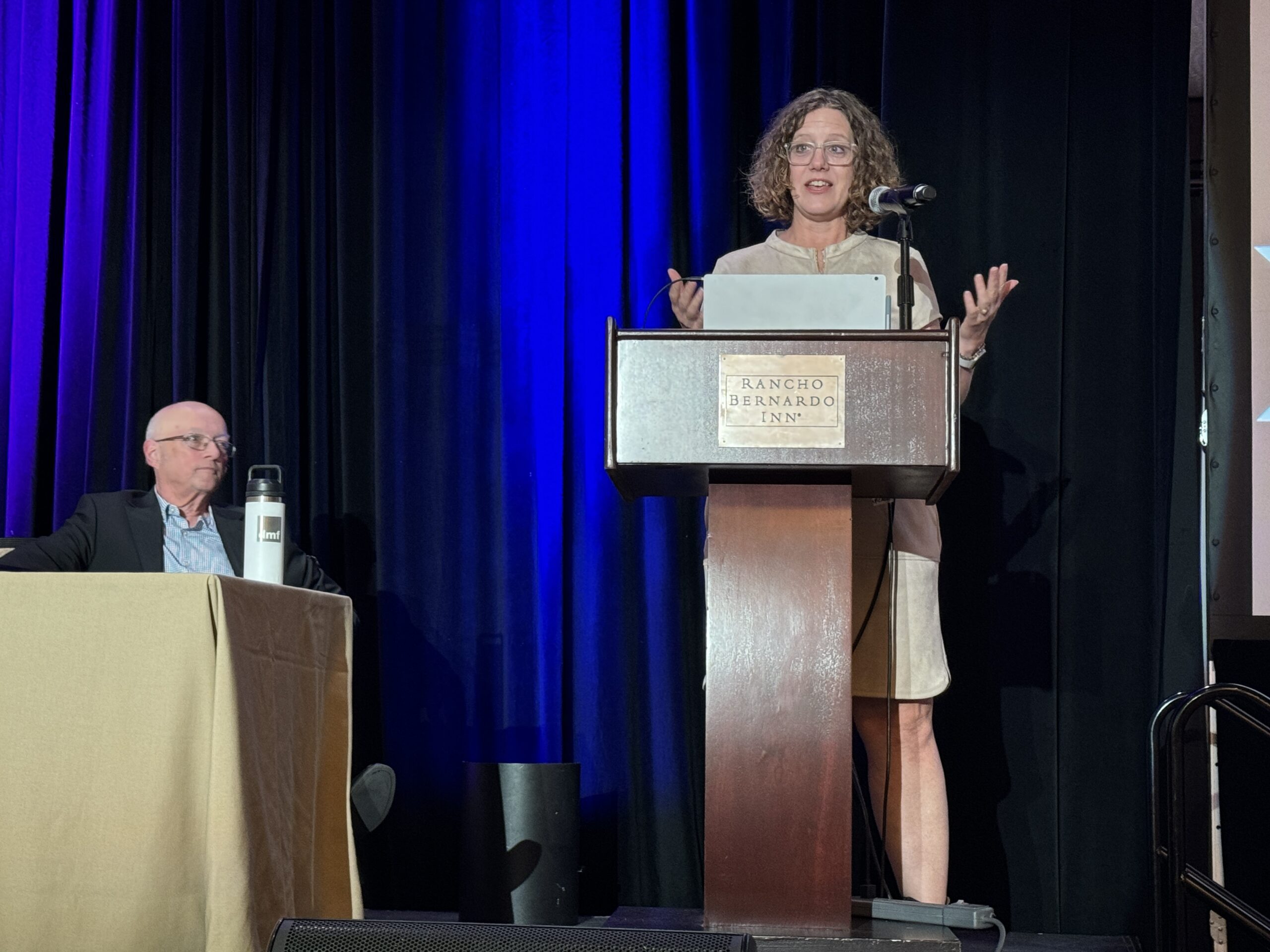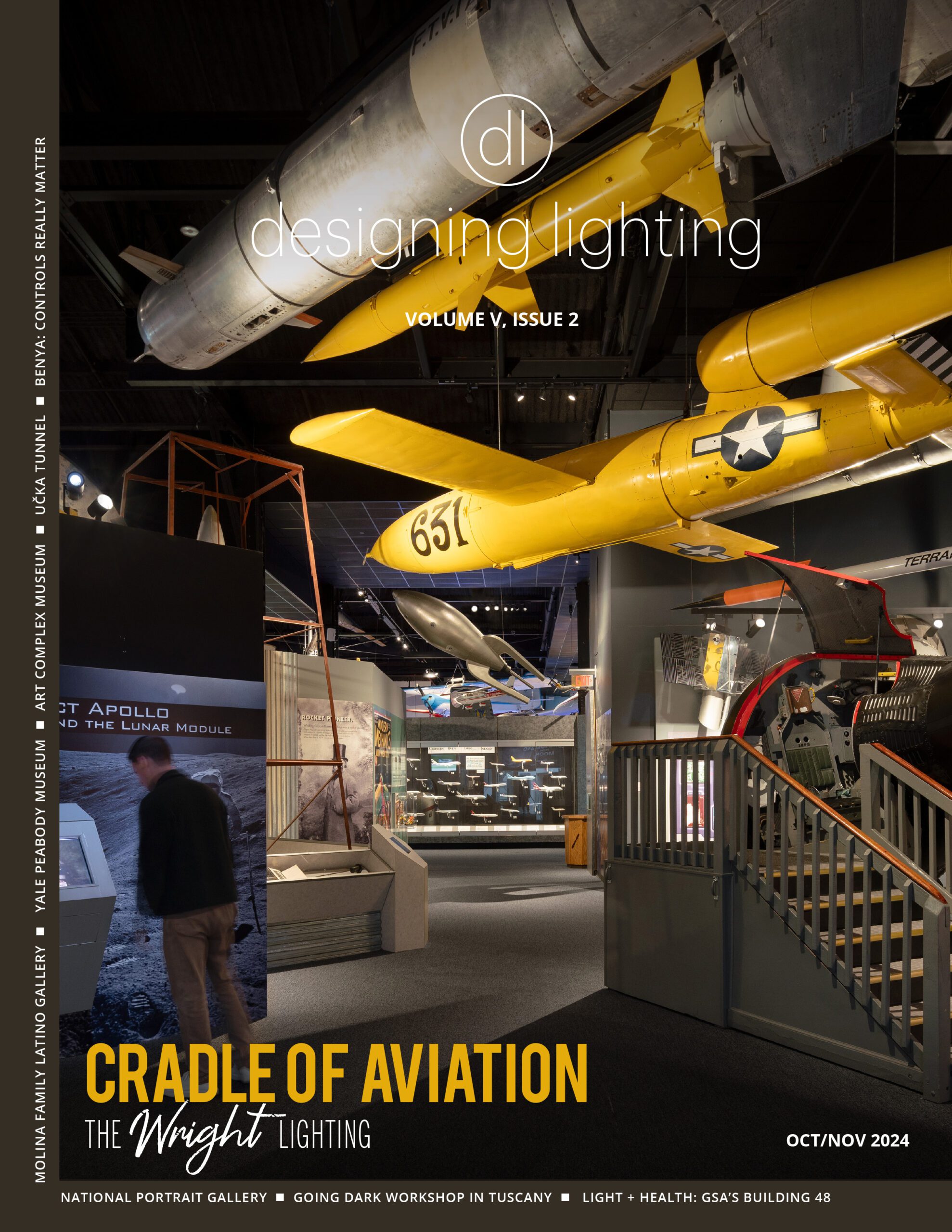The Gateway Arch, a symbol of St. Louis and American westward expansion, has undergone several lighting upgrades over the decades, reflecting advancements in lighting technology. Randy Burkett and Lisa Reed, partners at Reed Burkett Lighting Design, took the stage at the IALD Enlighten conference to discuss the Arch’s lighting history. Their session, Monuments of the Dream: 60 Years of Reflection, showcased the challenges and breakthroughs in lighting this national monument.
The 1960s: The First Attempt with High-Pressure Sodium
Randy Burkett opened with the first lighting attempt shortly after the Arch’s completion in the 1960s. Limited by the available technology, the design used high-pressure sodium lights. “Can you imagine using high-pressure sodium on stainless steel?” Randy asked, underscoring the impracticality of this approach. The sodium lights cast an orange glow, which, combined with the reflective surface of the Arch, created an overwhelming glare. “The technology simply wasn’t there to do it right,” Randy explained, showing video footage of the original mock-up. The results were so poor that the decision-makers wisely chose not to proceed with the installation. Lisa showed a video clip of Terry McGowan, reflecting on being at that trial in person in the 1960’s.
The Late 1990s: Xenon Lighting and the First Major Relighting
By the late 1990s, lighting technology had advanced, and the National Park Service sought a more sophisticated solution. Randy Burkett’s team was selected to design a new lighting system, this time using Xenon arc lamps. “This was one of the most technically challenging projects of my career,” Randy recalled, describing the difficulty in achieving the desired aesthetic while maintaining the integrity of the monument.
The new system involved 44 Xenon luminaires housed in four underground 55-foot-long concrete bunkers. “The Park Service was clear—no light fixtures could be visible above ground,” Randy explained. The luminaires were carefully aimed using linear spread lenses to provide an even wash of light across the Arch’s surface. The precision required for this was enormous. “We spent several nights, from 1 a.m. to 6 a.m., testing the lighting setup in complete secrecy,” Randy shared. The Xenon lights, producing a 3,000 Kelvin color temperature, illuminated the Arch effectively, but they required frequent replacement due to their short 1,000-hour lifespan. “We were constantly replacing lamps at $950 each, making it an expensive system to maintain,” Randy added.
Early 2000s: Improvements and Refinements
In the early 2000s, the team made several adjustments to improve the system’s performance. “The client wanted better longevity and energy efficiency,” Randy noted—the upgraded design featured newer Xenon sources with improved optics, reducing light spill and increasing precision. monument’s visibility,” Lisa Reed explained.
2014-2015: The LED Transition Consideration
By the mid-2010s, Randy was asked to light the arch for the second time. “The client wanted better longevity and energy efficiency,” Randy noted—the upgraded design featured newer Xenon sources with improved optics, reducing light spill and increasing precision. Your humble editor asked Randy if they considered LEDs. “We considered LEDs at that time,” Randy said, “but we weren’t fully convinced of their reliability, and the client was hesitant to adopt the technology too soon.” Instead, a more advanced version of Xenon was used for this round, though the team knew a full LED conversion was on the horizon.
2020s: The Final Move to LED
In the 2020s, LED technology had improved significantly, making it the clear choice for the Arch’s third relighting. Randy again received the call to do the relight. The team replaced the aging Xenon system with 1200-watt LED luminaires. “Switching to LEDs provided a huge leap in energy efficiency and lifespan,” Randy noted. The LED system was housed in the same underground bunkers used for the Xenon fixtures, ensuring the design integrity remained intact.
The LEDs offered superior precision optics and beam-shaping capabilities, allowing the team to direct light exactly where needed. “Each luminaire was fully dimmable, and we could shape the beams to eliminate unnecessary spill light,” Randy explained. This level of control met the National Park Service’s strict standards for even lighting, ensuring that visitors could enjoy unobstructed views of the monument from various vantage points around the city.
The team also implemented weather-sensing technology for fog and snow, which could scatter light and affect visibility. This was a significant step forward, especially given the Arch’s location within a key bird migratory corridor. To mitigate the impact on wildlife, the lights were turned off during migration seasons to prevent disorientation. “This was critical for protecting the local wildlife while maintaining the
Environmental Considerations and Future-Proofing
Environmental sustainability was a key concern in the latest relighting project. Randy and Lisa highlighted several measures taken to ensure the lighting system was as eco-friendly as possible. “We integrated weather-sensing technology that automatically dims or turns off lights during adverse weather,” Lisa explained. This feature not only protected wildlife but also helped reduce energy consumption. “This was especially important due to the Arch’s location in a migratory bird corridor,” Lisa added.
The LED system was designed to minimize light pollution. In addition to weather sensors, Randy elaborated, “We achieved over 95% light containment on clear nights, a significant improvement over previous systems. ” The team also rejected requests to implement color-changing displays, opting to maintain the Arch’s classic appearance without trendy lighting effects.

Lisa Reed at the podium at IALD Enlighten Americas
A Monument Lit for the Future
As Randy and Lisa reflected on their work relighting the Gateway Arch over the decades, they stressed the importance of balancing historical preservation with modern technological advancements. “The Arch is a national treasure, and our goal has always been to enhance its beauty while respecting its historical significance,” Randy said. Lisa added, “Lighting technology has come a long way since the 1960s, and it’s exciting to see where future innovations will take us.”
From the early attempts using high-pressure sodium to the precision of today’s LED technology, the relighting of the Gateway Arch stands as a testament to the evolution of lighting design. Each relighting project not only improved the monument’s visual impact but also addressed environmental responsibility, maintenance, and the growing expectations of both the public and the lighting industry.
By weaving cutting-edge technology into a historical landmark, Randy Burkett and Lisa Reed have ensured that the Gateway Arch remains a brilliantly illuminated symbol for future generations.
Read about the LIRC meeting at the IALD Enlighten America’s Conference 2024




